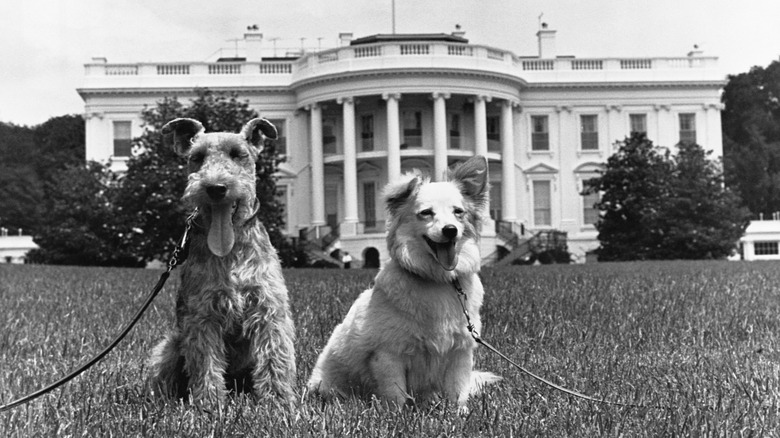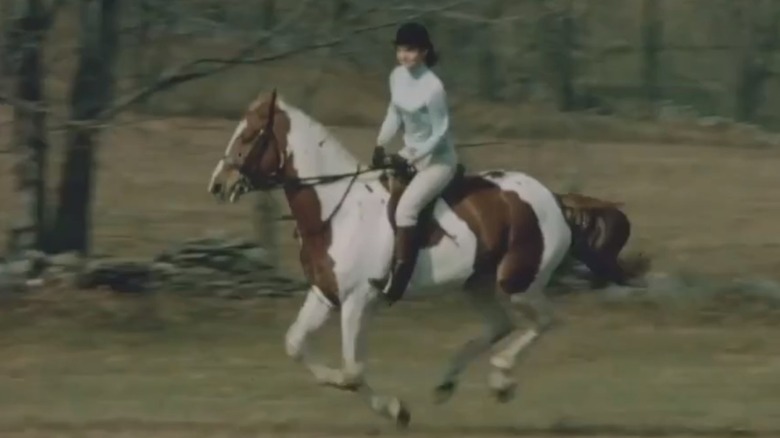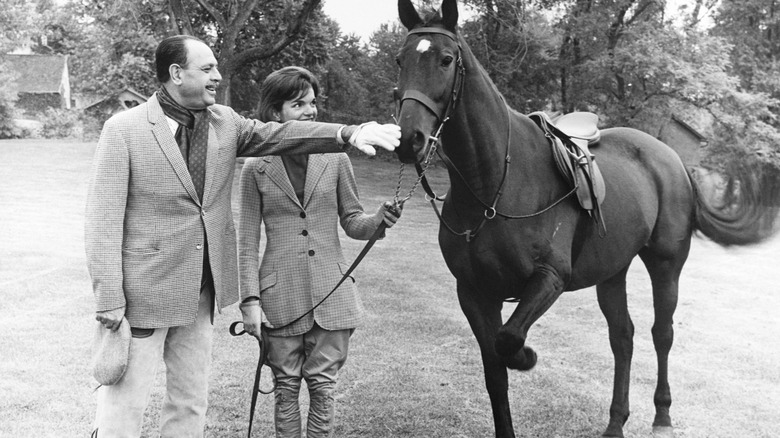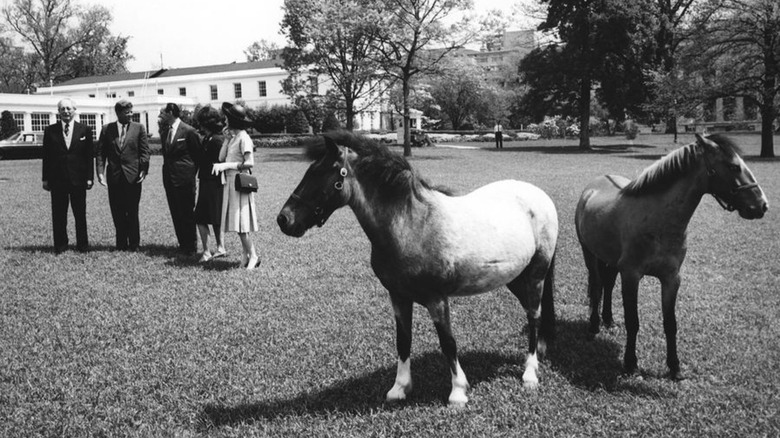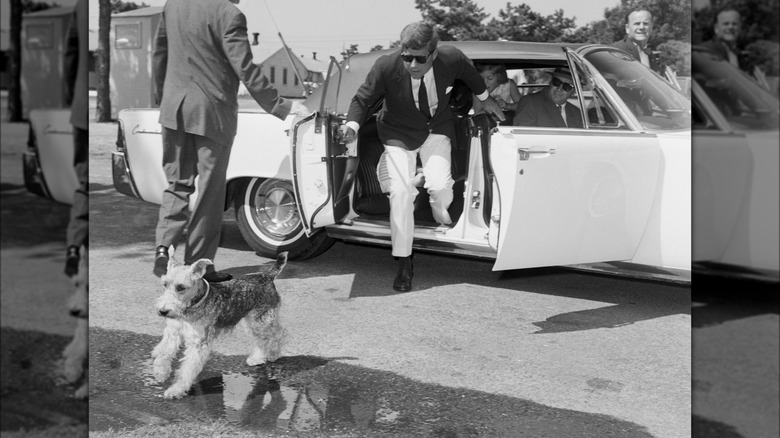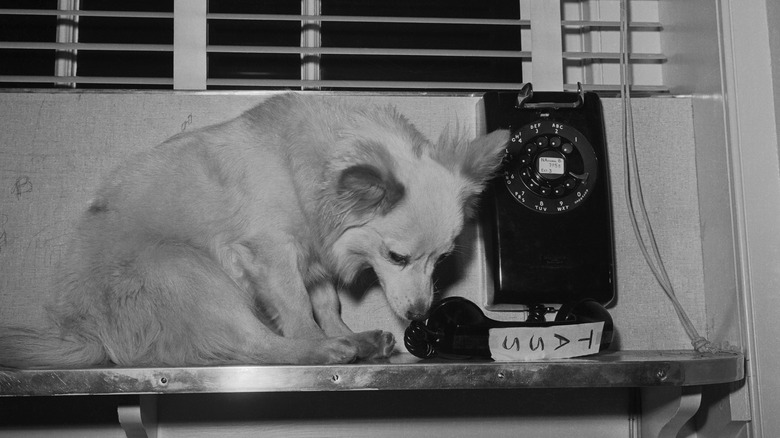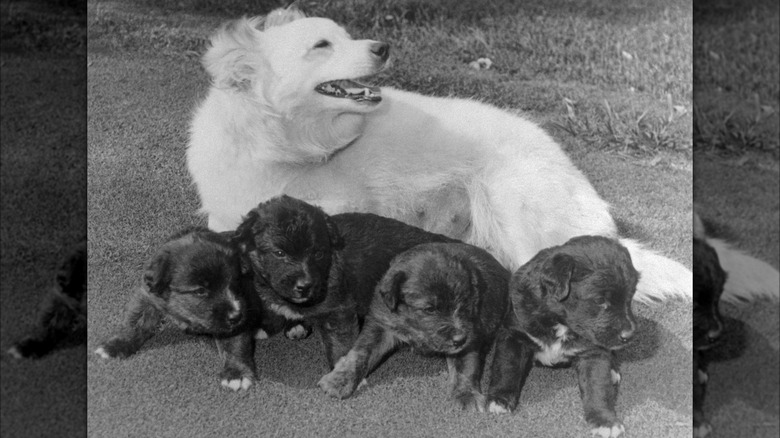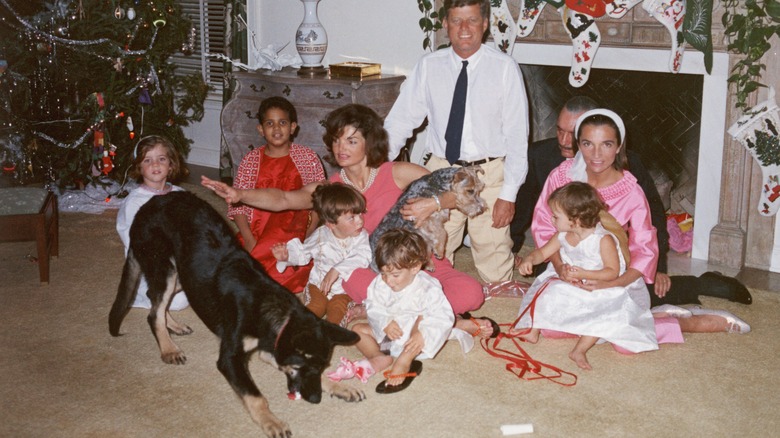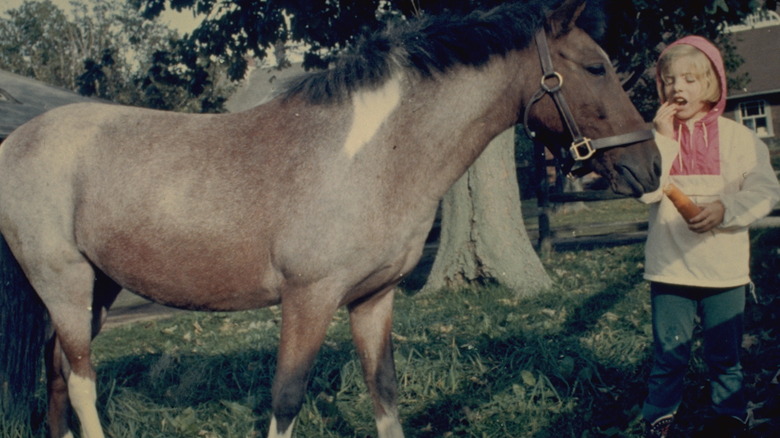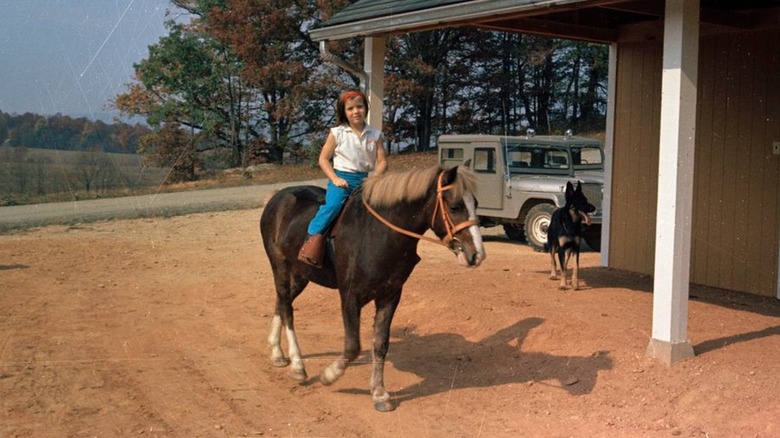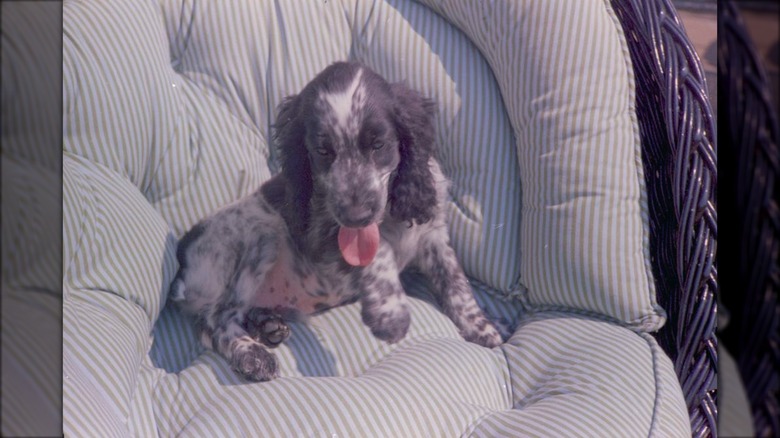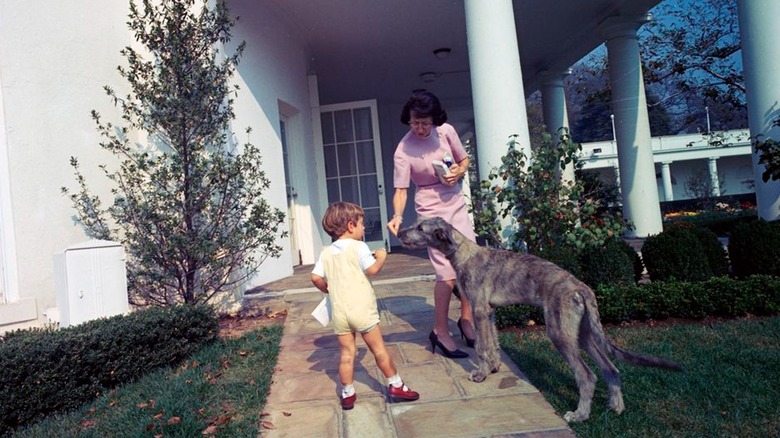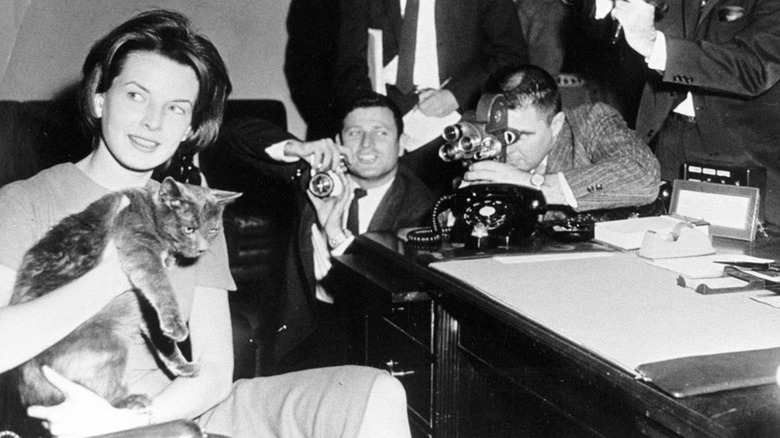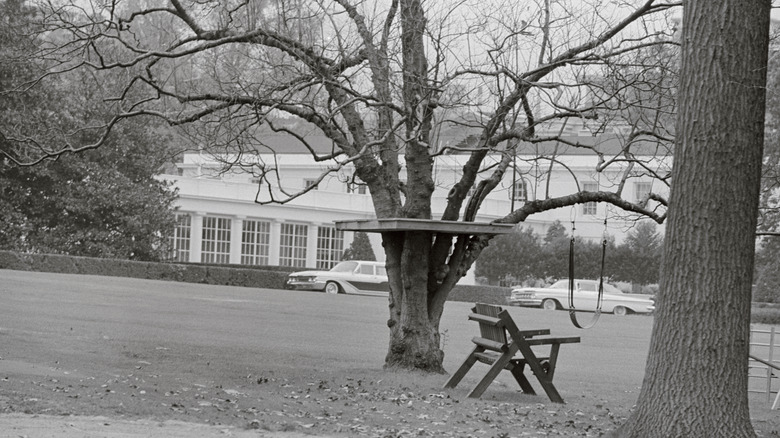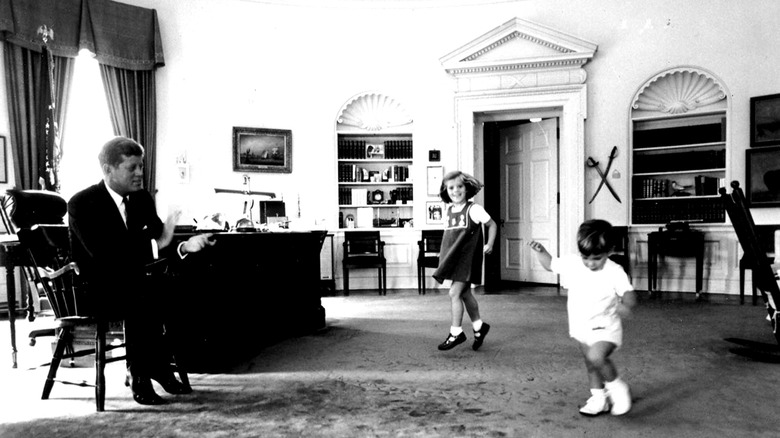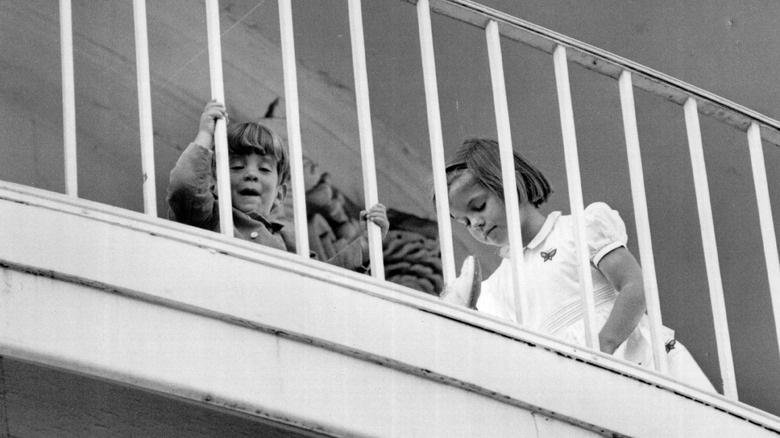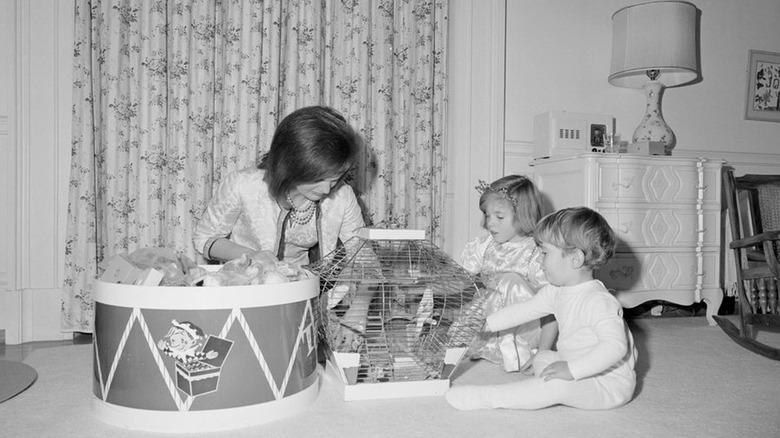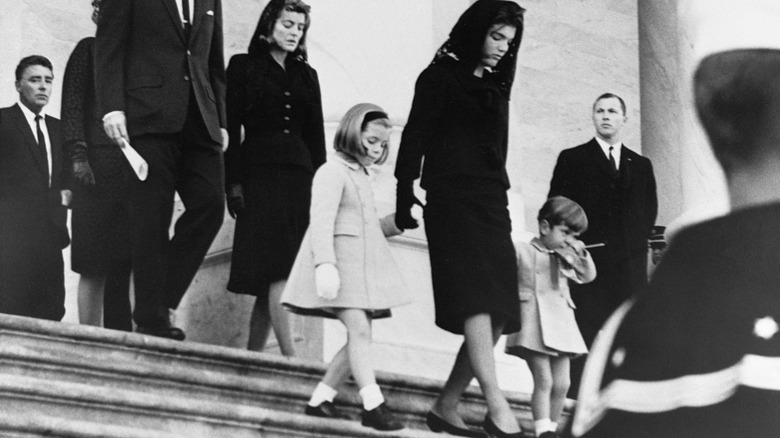Every Pet In The Kennedy-Era White House
It was one of John F. Kennedy's dogs — Pushinka, to be precise — that helped run a little interference between one of his many female visitors and Jackie Kennedy. At least, that is one of the stories told by White House electrician and kennelmaster Traphes Bryant in his book, "Dog Days at the White House: The Outrageous Memoirs of the Presidential Kennel Keeper." According to Bryant, it was common practice for JFK to invite some female company to the White House when Jackie left, and skinny-dipping was such a common thing, too, that he insisted on the installation of frosted glass. On one occasion, JFK's visitor was held up when she wanted to meet Pushinka before joining the president in the pool, and it was a good thing, too — Jackie chose that time to return.
Bryant says that the Kennedy dogs filled a very important role in the family: "I was sure that the Kennedy's dogs were somehow helpful in their marriage, a means they had of communicating with each other in a close and affectionate way." He recalled that they often walked their dogs together as a way of getting some alone time — to share, or to work things out.
The Kennedy-era White House was nothing short of a menagerie, but Bryant says that as far as JFK was concerned, there was a clear favorite. That was Charlie, the Welsh terrier who was the only pet to move into the White House with them. Others came later, and there were a lot.
Rufus (and Bit of Irish)
Not all of the Kennedy-era pets were kept on the grounds of the White House, and according to Vanity Fair, stabling a few of Jackie Kennedy's horses in a manner she felt befitting to them caused some problems. When JFK was elected, Jackie had two horses: Rufus, and Bit of Irish. They were kept at a nearby estate in Glen Ora, and yes, it was the sort of place that had a private heliport.
Surprisingly, there's not that much information available about either horse, likely because they were kept away from the prying public eyes that were on the White House. Interestingly, there's so little that's known about them that there's information listed by the John F. Kennedy Presidential Library and Museum that's wrong: Rufus is described as a palomino, but he wasn't — he was the brown-and-white piebald pictured above. (Bit of Irish was a bay gelding.)
Rufus gets a small mention in Vicky Moon's "The Private Passion of Jackie Kennedy Onassis: Portrait of a Rider." He was the result of an accidental breeding and was named after the local vet, but ended up being such a solid riding horse that he was credited with giving her confidence as a rider, and confidence to also ride with John Jr. in front of her. Bit of Irish gets less of a mention: He was named in honor of JFK's Irish heritage, and was the horse she was riding when she took a high-profile fall during a fox hunt.
Sardar
Jackie Kennedy's acquisition of the bay gelding Sardar ended up being incredibly problematic for the White House. Why? He was a very expensive personal gift from Pakistan's President Ayub Khan (pictured, with her and Sardar). Kennedy had been on a state visit when she struck up a friendship with the horse-loving president, and when he gifted her the horse that she rode while she was there, it was the start of some big issues.
According to Vicky Moon's "The Private Passion of Jackie Kennedy Onassis: Portrait of a Rider," she accepted the gift, got Sardar on a transport to the states, and then wrote her husband and told him to pull some strings: "He is so beautiful and high strung it would be cruel to quarantine him in New York for thirty days," she wrote. "Cannot bear to be parted from him that long ... Could you not have veterinarian examine him in New York and say he was free from all disease and (have him go straight) to Glen-Ora." She went on to say that it was such a big deal that observing the mandatory quarantine period was likely to lose him the support of the ASPCA, to which the president responded he was "doing nothing but taking care of Sardar."
Sardar was reportedly subjected to a fire hose spray with fungicide, then sent on to his more permanent home. He became a staple at horse shows — including the Washington International Horse Show.
Tex
It's safe to say that not many people will argue with the idea that the Kennedy family is pretty much America's version of the royals, and their herd of horses didn't help matters, even when they reached the White House. According to Vicky Moon's "The Private Passion of Jackie Kennedy Onassis: Portrait of a Rider," longtime Kennedy adviser Fred Dutton said that they were well aware of just how it looked to have the first lady keeping a stable full of very expensive horses: "From the view inside, we thought Mrs. Kennedy's horses were pretty aristocratic, and didn't play well with Joe Sixpack."
That led to an official recommendation that they not accept any more horses gifted from overseas, but that didn't keep the herd from growing. A wild buckskin yearling (right) was added to the menagerie when he was gifted to the family by Lyndon B. Johnson, after being bred on the ranch belonging to John B. Connally. (Connally would famously be wounded during JFK's assassination.)
Originally named Little John, he was renamed Tex and came with a massive caveat: Do not let the children ride him until he's been through some extensive and professional training. When he was handed over to a trainer, he was described as being pretty much impossible to even handle. But it wasn't long until — under the guidance of professional trainers — Tex was at a point where he'd been turned into a children's pony, often seen trotting around the White House lawn with a young rider.
Charlie
In his memoir, "Dog Days at the White House," kennelmaster Traphes Bryant shared a hilarious diary that was prefaced by a disclaimer that the Kennedy family had a rule: "A dog could do no wrong." He continued: "A White House policeman asked me if my foot was wet. I said, 'No, it's not raining.' He grinned and I looked down and Charlie was just putting his hind leg down. Then Charlie did the same thing on Mrs. Kennedy."
Charlie — a Welsh terrier — was apparently JFK's favorite, and yes, that's him chasing the runaway Charlie. Troublesome as he was, he also had a role as a trusted confidant: Bryant recalled the chaos of the Cuban missile crisis, saying that he had truly thought that the country was on the brink of war. JFK needed a moment to compose himself, and who did he ask for? Charlie. "He petted the dog, and it seemed to relieve his tension," Bryant recalled.
It was Charlie, too, who would often join JFK for swimming in the White House pool, and if there are any doubts that he could do no wrong, Bryant's anecdotes about his tendency to bite White House workers confirm it. "He would slip up behind a worker ... and bite him in the seat of his pants or grab his leg. Then he would run like hell ... But nobody wanted to take it to the President. I guess they figured if they couldn't get along with Charlie and it was a choice of who would go, Charlie would stay."
Pushinka
It was Caroline Kennedy who later explained how — at the height of the Cold War — her family had ended up with a Russian dog in the White House. She told the BBC that her mother had been at a state dinner in Vienna when she found herself seated next to Nikita Khrushchev. "She ran out of things to talk about, so she asked about the dog, Strelka, that the Russians had shot into space. During the conversation, my mother asked about Strelka's puppies. A few months later, a puppy arrived and my father had no idea where the dog came from, and couldn't believe my mother had done that."
If it seems like a gift from Russia would raise eyebrows, it definitely did. In his book "Dog Days at the White House," Traphes Bryant revealed that before Pushinka was allowed to join her new family, she had to undergo a thorough inspection that included scanning for listening devices.
While Pushinka passed her security clearance and officially became one of the highest-profile members of the Kennedy-era White House, Bryant says that he still didn't trust her. He described her as the sort of dog that was likely to snap, and did — not only did she snap at the face of one visiting child, Bryant was worried enough that he voiced his concerns to others. They were brushed aside, but Caroline Kennedy later said they believed her unpredictable nipping was rooted in her early days: She'd been raised in a laboratory.
Charlie and Pushinka's puppies
Today, it's an oft-repeated bit of wisdom : Spay or neuter your pets. As far as the Kennedy family was concerned? That apparently wasn't important, and the inevitable happened: puppies. In "Dog Days at the White House," Traphes Bryant wrote that it was Jackie and Caroline Kennedy who named the four puppies Blackie, White Tip, Butterfly, and Streaker, and he wrote that the puppies' arrival was a big deal. Pushinka (who had previously lost a litter of puppies, in spite of being taken to Walter Reed Hospital for care), the pups, and Bryant traveled to Hyannis Port via a military plane, and Bryant wrote that they had a very different introduction to their world than the one their mother had gotten.
"All day, life at the rented house centered around the puppies. The children would romp and tumble about with the dogs. The first lady was anxious for them to learn to handle the dogs with kindness." He shared one tearful memory: JFK's father was severely ailing, but "when [JFK] put a puppy in his father's lap and his father seemed to respond. This was in June 1963. In November not the father but the son was dead."
The puppies didn't spend their entire lives in the White House. Two went to family friends, while the other two — Butterfly and Streaker — were given to two of the around 5,000 people who wrote to the Kennedys and offered to adopt the pups. They were nicknamed "pupniks."
Clipper
Many people have an overly optimistic view of how well their dogs are trained, and according to Traphes Bryant (via "Dogs Days at the White House”), that was kind of the case with the Kennedys, too. Jackie Kennedy was always adamant that her dogs didn't need to be leashed because they absolutely and unconditionally listened to her, but Bryant always insisted — thankfully. When she and JFK would take them on walks, it was invariably Charlie and Clipper, the German shepherd that was gifted to Jackie by her father-in-law.
And Clipper had a wild streak. Bryant recalled him taking out a screen door in an attempt to flee from the sound of a helicopter, and also wrote that it was Clipper who had gotten him in trouble. He was exercising the big dog by playing fetch when he was summoned into the White House from the yard and told to never, ever do that again.
"Later, I found out why the President had gotten so excited. The President had been practicing his golf swing and Clipper had leaped for the club when he had it over his shoulder. Clipper had almost succeeded in dislocating the presidential arm. The President ended up swinging club and dog." Bryant also recalled JFK's response when he tried to warn him about security in crowds: Clipper had a particular dislike for one of the family's other dogs, and JFK suggested that getting between the two animals was more dangerous than any crowd could ever be.
Macaroni
It's every child's dream to look out their window on one birthday morning and see their very own pony in the yard, and when you're a Kennedy? Of course, you're not just getting one pony, you're getting a bunch of them. In the most famous photos of Caroline Kennedy riding around the White House lawn on a pony so chubby that trotting looks like it's just off the table, that's a pony called Macaroni.
Macaroni came from a local horse trainer, and came to the Kennedy family after they put out a call for a well-trained, kid-safe pony via their local horse friends. How docile was he? In Vicky Moon's "The Private Passion of Jackie Kennedy Onassis," Macaroni's original owner and trainer, Barney Brittle, recalled how the Kennedy family kept in touch with him and updated him as to the pony's progress ... or, more accurately, shenanigans. In one phone call, Jackie admitted that Caroline had raided her stash of nail polish, and that the end result was that Macaroni was now sporting bright red hooves.
Macaroni's appetite was legendary, and he was notorious for not only grazing on the White House lawn, but growing so overweight from treats given to him by anyone who could reach through the fence that another fence needed to be installed. He ate a good portion of the landscape's roses, and when he wasn't entertaining the children or wowing the visitors, he lived in a converted potting shed.
Leprechaun (and two deer)
The Kennedy family's connection to Ireland is pretty well documented, so it's not really surprising that when it came time to add another pony to the mix, they looked across the Atlantic ... sort of. When Irish President Eamon de Valera offered to gift the family not only a Connemara pony, but also two deer and an actual person to care for the pony, the initial gift was refused when some in the Kennedy camp pointed out that it might not look well in a diplomatic sort of way.
The offer was eventually accepted, and the pony was appropriately (if not predictably) named Leprechaun. He joined Macaroni on the White House lawn, and he didn't make the trip alone: He was accompanied by the two deer, who were also destined for White House lawn life.
Macaroni's original owner and trainer, Barney Brittle, was setting up a shed that was going to act as a stable for the two deer when a Secret Service agent told him about what had just happened in Dallas. "That was before it hit the radio," he said in Vicky Moon's "The Private Passion of Jackie Kennedy Onassis." "I know something nobody knows," he continued. "They were going straight to the farm to spend more time together. That's not hearsay; she told me that directly, it didn't come from the servants. ... It looked like they were going to get it together."
Shannon
Shannon the cocker spaniel was another gift from Ireland, and sources vary as to where, exactly, the pup came from. According to Traphes Bryant's book "Dog Days at the White House," Shannon was a gift from Irish leader Eamon de Valera. The Limerick Leader tells a different story, though: The Barry family of Caherconlish reportedly gave Shannon to the president — who just happened to also be a third cousin of the family's Imelda Barry. Barry bred award-winning cocker spaniels, and the family was reportedly thrilled when Jackie Kennedy later sent one of Shannon's puppies back to them.
Bryant wrote that Shannon's arrival brought some difficulties along with it, and said that it was basically at the point where there were just so many dogs, there were bound to be personality conflicts. Clipper the German shepherd in particular didn't like Shannon, and when it came time for him to try to set up their beds and personal spaces in Hyannis Port, it was a massive challenge.
And yes, he also wrote: It was just as loud and as unruly as one would think. "Everyone had fun with the Kennedy dogs — except the neighbors."
Wolf
The downside to Irish wolfhounds is that they only have an expected lifespan of between six and eight years, which means that getting one implies heartbreak isn't too far down the road. They're typically known for being not just massive (weighing up to 180 pounds), but also for being gentle giants. They're great dogs, but the Irish wolfhound gifted to the Kennedy family and — again, predictably — named Wolf, was fine with most people ... but hated other dogs.
Wolf was a gift from a Dublin priest, and when it came time for Traphes Bryant to find places for the dogs at the Kennedy homestead in Hyannis Port, Wolf was relegated to the garage. He and Charlie didn't get along, and when Brant recounted a particularly harrowing experience in his memoir, "Dog Days at the White House," he was holding the leashed of Wolf and the German Shepherd, Clipper, as they growled and snarled at each other.
It was Wolf who featured in Bryant's last memories of JFK. He wrote that he had been walking the wolfhound when JFK told him that Charlie had snapped at Jackie Kennedy: "That was the last time I heard his voice. Two days later he was dead. I thought I could never feel emotion about a President again, never laugh with one, never feel close to one. ... At first everything reminded me of Kennedy."
Tom Kitten
Presidential historian and author Carl Anthony is an expert on the everyday lives that go on in the White House, and when he took a look at presidential pets, he noticed something pretty appropriate. Just as the election of JFK was seen as a historic moment that put the country on the brink of some long overdue and much-needed changes, there was a change in presidential pets, too: There was a cat in the White House for the first time since Calvin Coolidge's late 1920s presidency.
Sort of. Tom Kitten was technically Caroline Kennedy's cat, but given that JFK was severely allergic to him, his actual time in the White House was limited to times that the president was away. It was only then that Tom Kitten's keeper — Jackie Kennedy's secretary, Mary Gallagher — would bring the kitten to work with her.
The last time that happened was in October of 1963. By then, Tom Kitten was no longer a kitten and had been renamed Tom Terrific, and with his departure, there would be no cat in the White House again for more than a decade. Tom Kitten, meanwhile, was still in Gallagher's care when he died: In her memoir, "My Life with Jacqueline Kennedy," Gallagher recalled the family coming to visit the cat regularly, and when he died, she wired the sad news to Jackie and Caroline in Italy.
Caroline Kennedy's ducks
In his memoir, "Dog Days at the White House," Traphes Bryant revealed that it was Jackie Kennedy who decided that she wanted to get ducks to add to the White House's menagerie. A small flock was brought in and installed around the South Fountain, but it very quickly became clear that it wasn't a good idea — not with the presence of a Welsh terrier who not only liked to swim, but who also liked to chase ducks.
It turns out that the famously peaceful picture of the little flock of white ducks waddling their way across the White House lawn was the exception, and not the norm. Bryant confirmed that yes, there were times that Charlie didn't just chase the ducks, but at least once, he grabbed one and refused to let it go. Nearby security was able to grab the dog and rescue the duck, but that particular duck never took a dip in the fountain again, understandably traumatized by the experience.
Hamsters. Lots and lots of hamsters
For countless children, hamsters are sort of the introduction to pets: There's no need to walk them and they're pretty low-maintenance, so they're typically seen as a safer option than jumping right into getting a cat or a dog. While the Kennedy children had plenty of those animals, Jackie Kennedy's secretary, Mary Gallagher, wrote in her memoir, "My Life with Jacqueline Kennedy," that "Hamsters outnumbered everything, including people. "There was the time when one of them drowned in the President's bathtub. And one morning, as I entered my office and turned on the light by my desk, out ran a mouse-like creature. I emitted a wild shriek, breaking the serenity of the most dignified surroundings of the land."
The drowning incident was also mentioned by Traphes Bryant in his memoirs, along with another incident that, well, demonstrates the fact that owning hamsters isn't necessarily for the faint of heart after all: He described them as "a family of hamsters, like something out of a Greek tragedy."
Not only did one drown, but when mama hamster gave birth, the babies were reportedly killed and eaten by the father ... who was then, in turn, killed by the mother hamster. "I think Caroline learned a lot about tragedy from this — the hard way," Bryant wrote.
Zsa Zsa (and other unnamed rabbits)
The Kennedy children also had rabbits, and let's be honest here: Rabbits aren't actually easy-as-pie children's pets, either. Although there seems to have been multiple rabbits, the one that gets the most mentions in various sources is Zsa Zsa. She was obviously named after the actress Zsa Zsa Gabor, which isn't odd in itself. What is odd is that Gabor herself has spoken about her relationship with JFK, saying (via ET), "When I was in America he took me out for three months. I never slept with him. He slept with everybody. He took me out because he liked to be with me."
Don't worry, this gets weirder. In 1961, LIFE questioned Kennedy press secretary Pierre Salinger about the rabbit, he claimed that the rabbit wasn't going to be staying with the family, and was instead going to be sent on to an orphanage. Oh, and that she had been a gift from a Pittsburgh magician who claimed she could play patriotic tunes on a trumpet.
Vicky Moon's "The Private Passion of Jackie Kennedy Onassis" suggests that instead, the rabbits — including Zsa Zsa — were kept in a hutch in the White House's private school. Moon also names another one of the little group, and says that it was Annabelle who taught the children a very important lesson about the circle of life when she killed and ate her four baby bunnies. Moon wrote, "It was a very perplexing situation to explain to the children."
Robin, Bluebelle, and Maybelle
In 1963, the White House issued a formal request in the run-up to Jackie Kennedy's birthday. It was reported in the Sarasota Herald-Tribune, and started with something pretty important: "Please, No More Pets!" They had plenty at the time, and it was stressed that any pets sent to the White House would be rehomed elsewhere. (It also blamed JFK for starting the trend of accepting gifted pets when he took home some ducks.)
Buried in the story is a bit of information on some of their often-overlooked pets, which were a group of three small birds. At the time, the Kennedy kids had two parakeets — Bluebelle and Maybelle — and they had just said goodbye to another feathery resident. Caroline Kennedy had a canary named Robin, and when the little bird died in 1962, he was buried in a solemn ceremony that took place near the White House's outside playground.
What happened after the assassination?
Jackie Kennedy and her children left the White House two weeks after the assassination of JFK: What happened to their pets is, in some cases, difficult to track down. Let's talk about what we do know, starting with the pets that remained with the family. According to coverage in the Pittsburgh Post-Gazette, two cages with Caroline and John Jr.'s parakeets were moved into their new Georgetown home ahead of them.
Jackie opted to keep only a single one of their dogs: Shannon. In his memoir, "Dog Days at the White House," Traphes Bryant wrote that he had wholeheartedly disagreed with the decision, saying that it had been cruel to take the dogs away from the children while they were grieving their father's loss. He wrote, "It had been strictly Jacqueline's decision. ... [She] made it clear she didn't want the trouble or the expense of taking all the dogs." Where did they go? According to animal trainer Dr. Margaret Reed, author of "The Dogs of Camelot" (via The Cape Cod Times), they were rehomed with close friends and professional associates.
It's unclear exactly what happened to the Kennedy's horses, but in her book "The Private Passion of Jackie Kennedy Onassis," Vicky Moon says that Jackie found at least some comfort — or solitude, away from prying eyes — while regularly riding Sardar. Coverage from The New York Times in 1964 reveals that the deer were donated to the Central Park Children's Zoo.
